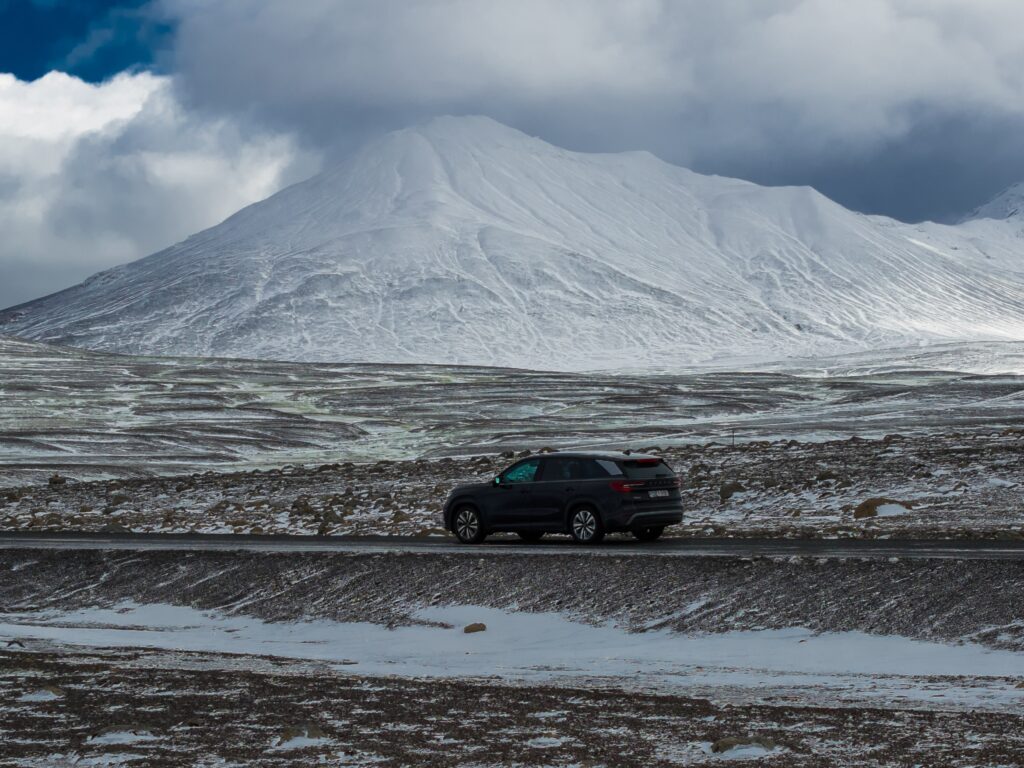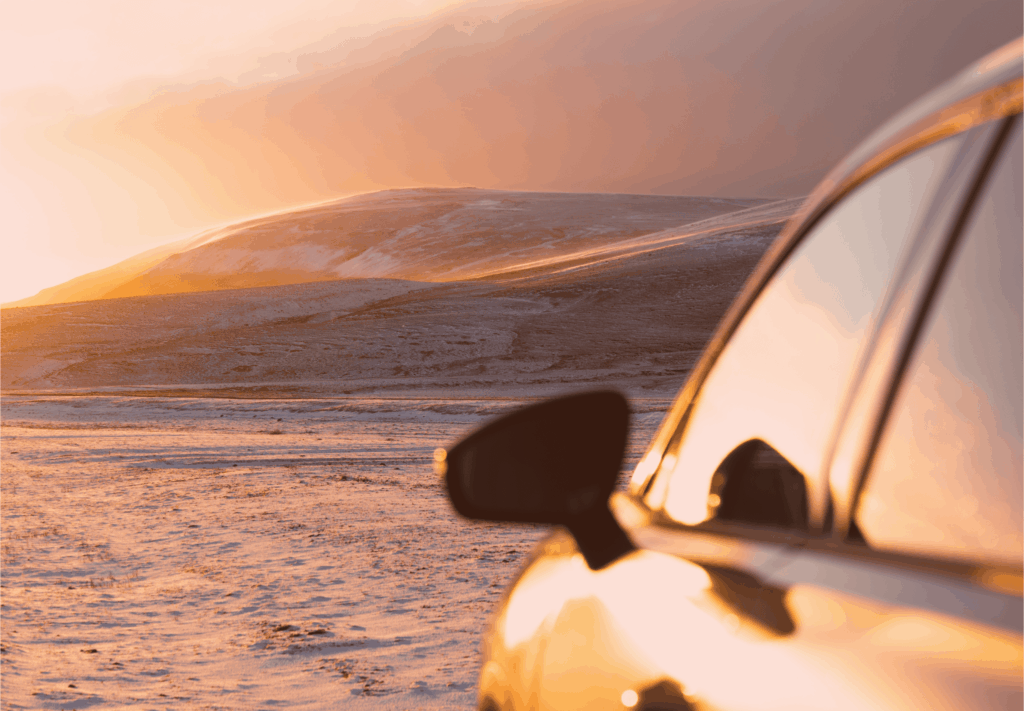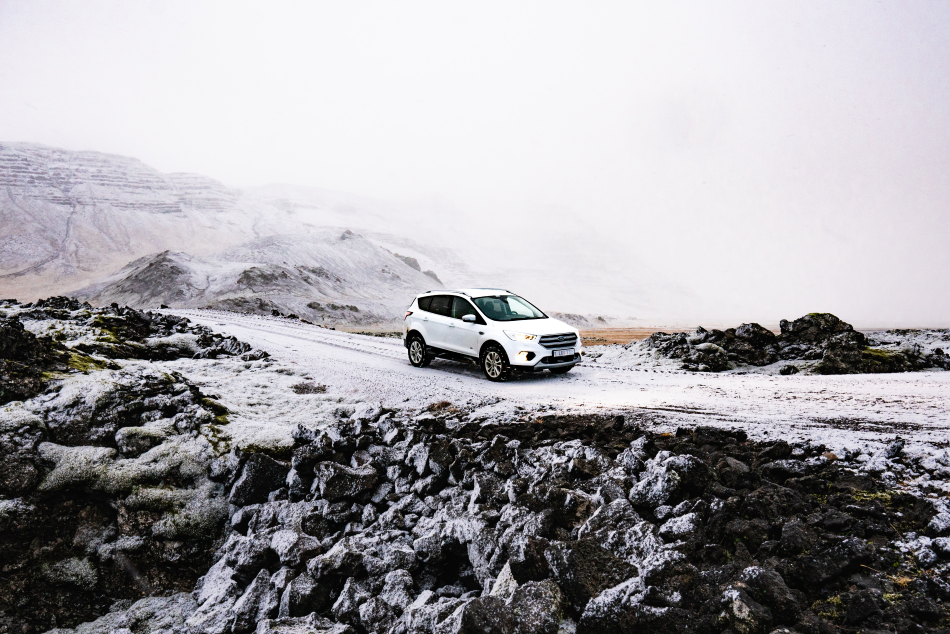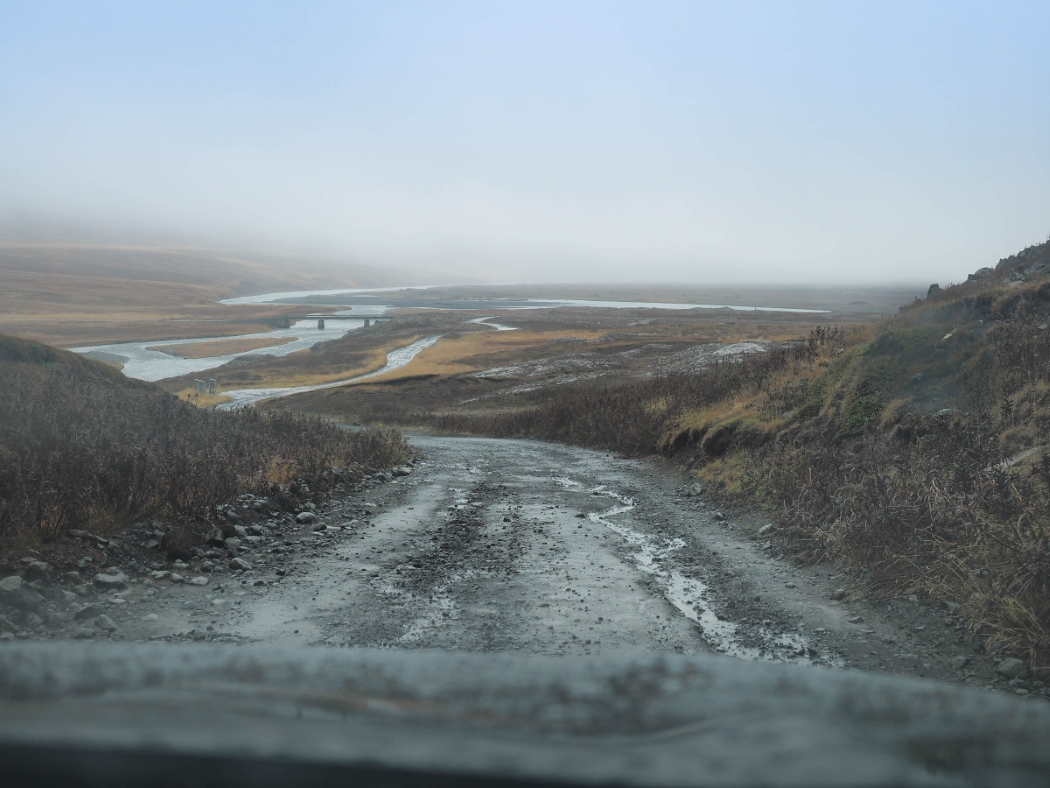Last updated: October 2025
Driving in Iceland during winter can be magical — but it’s also challenging.
Snow, ice, high winds, and short daylight hours mean preparation is key.
Here’s how to stay safe on Iceland’s winter roads and make your road trip unforgettable for all the right reasons.
Quick Facts: What You Must Know About Winter Driving in Iceland
- 4×4 vehicles are strongly recommended from October to April.
- Studded winter tyres are mandatory for all rental cars in winter.
- Headlights must be on 24/7, even during bright daylight.
- Off-road driving is illegal — never drive on snow-covered terrain without visible tracks.
- Check Road.is for daily road conditions and Vedur.is for weather warnings before driving.
- Avoid night driving when possible — daylight is limited to 4–6 hours midwinter.
- Carry warm clothing, snacks, and water in case of delays or closures.

Q: How Should I Drive on Ice in Iceland?
Driving on ice requires slow, smooth, and steady control.
- Avoid sudden braking or acceleration — both can cause the car to skid.
- Use low gears when going downhill or approaching turns.
- Increase following distance (at least 5–6 seconds) between you and the car ahead.
- Never use cruise control on icy roads.
- If your car starts to slide, steer gently in the direction of the skid until you regain control.
Even with studded tyres, icy patches can appear without warning — especially on shaded sections, bridges, or near lakes and rivers.
Q: How Can I Tell If There’s Ice on the Road?
Ice can be nearly invisible, often called black ice.
It commonly forms when:
- The air temperature is between –2°C and +3°C.
- You’re driving near water or wetlands.
- The road is shaded or sheltered from wind.
- It has recently rained or snowed, and the road looks shiny.
If the road surface looks glossy or darker than usual, assume it’s icy and slow down.
Q: What Should I Do If I’m Driving on Snow?
Driving on snow requires patience and gentle handling.
- Accelerate slowly to prevent spinning the tyres.
- Use existing tyre tracks instead of creating new ones.
- Keep your steering movements smooth and avoid sharp turns.
- When braking, apply gentle pressure — avoid slamming on the brakes.
- If you get stuck, rock the car gently forward and back to gain momentum.
If visibility drops or snowdrifts form, pull over in a safe spot and wait for conditions to improve.
Q: What Should I Do If My Car Gets Stuck in Snow?
- Don’t spin the wheels — it only digs you deeper.
- Clear snow around the tyres if possible.
- Try shifting between Drive and Reverse (in automatics) or 1st and 2nd gear (in manuals) to rock the car gently.
- Reduce air pressure slightly in the tyres to increase grip (only if you can refill later).
- If you cannot move safely, stay in the vehicle, turn on hazard lights, and call Thrifty’s 24/7 roadside assistance.
Winter Hazards in Iceland: Common Issues and What to Do
| Hazard | Effect on Driving | What to Do |
|---|---|---|
| Black Ice | Loss of traction, hard to see | Reduce speed, avoid braking or turning suddenly |
| Heavy Snowfall | Poor visibility, deep snow | Use headlights, follow existing tracks, avoid night driving |
| Strong Crosswinds | Pushes car sideways | Hold steering firmly, reduce speed, avoid opening doors suddenly |
| Sun Glare on Ice | Temporary blindness | Wear sunglasses, slow down when sun is low on the horizon |
| Snow Drifts on Road | Blocks lane or hides edges | Don’t force through; stop safely and reassess route |
| Low Daylight Hours | Fatigue, visibility issues | Plan shorter drives and finish before dark |
Q: Can I Drive on F-Roads in Winter?
No.
F-roads (mountain roads) are closed from roughly September to June, depending on snow and weather.
Attempting to drive on closed roads is illegal and can result in fines and rescue charges.
For highland routes or off-paved adventures, plan your visit between late June and early September.
For more info, visit our F-Roads in Iceland Guide.
Q: What Should I Do If There’s a Road Closure?
If you see a “Road Closed (Lokað)” sign — stop immediately.
Never drive past closure gates or warnings.
These roads are often blocked by snow or flooding and are unsafe.
Stay put, check Road.is for updates, or find alternative routes along the Ring Road.
Q: Are Snow Chains Needed in Iceland?
No, snow chains are rarely used in Iceland.
Rental cars are already fitted with winter or studded tyres, which perform better on snow and ice than chains.
In fact, using chains on paved or gravel roads can cause damage and is not recommended unless advised by local authorities.
Q: What Time Does It Get Dark in Winter?
During December and January, daylight in Iceland lasts around 4–5 hours per day.
In February and March, it gradually extends to 8–10 hours.
Always plan your drives during daylight for best safety and visibility.

Q: What Car Type Is Best for Winter Driving in Iceland?
Choose a 4×4 SUV with good ground clearance and studded tyres.
Here’s a quick comparison to help you pick the right vehicle for your winter road trip:
| Trip Type / Route | Recommended Vehicle | Why It’s Best for Winter |
|---|---|---|
| Reykjavik city & short drives | Compact 2WD | Easier parking, fully paved roads |
| Golden Circle & South Coast | 4×4 SUV | More control on snow and wind-exposed roads |
| Ring Road in winter | Mid or large 4×4 | Stable at long distances and icy sections |
| Westfjords / remote routes | 4×4 SUV with studded tyres | Handles snow, ice, and gravel confidently |
| Highlands (F-roads) | Closed in winter | F-roads are not accessible until summer |
Q: What’s the Best Way to Prepare Before Driving?
- Check Road.is (road conditions) and Vedur.is (weather forecast) daily.
- Make sure your fuel tank is over half full.
- Keep charged phone, warm blanket, water, and snacks in the car.
- Always scrape off all snow and ice from windows and mirrors before driving.
- If in doubt — wait. Iceland’s weather changes fast.
Emergency Numbers and Assistance
- Emergency (Police / Fire / Ambulance): 112
- Road Conditions: www.road.is
- Weather Forecast: www.vedur.is
- Thrifty Road Assistance: 24/7 phone number on your rental agreement
If you get stuck or stranded, stay in your car, turn on hazard lights, and wait for help.
Related Driving Guides
- Driving in Iceland: Rules and Safety Tips
- F-Roads in Iceland: What You Need to Know
- Choosing the Right 4×4 for Iceland Winter Travel
- Iceland Car Rental Insurance Explained

Important Information
Driving in Iceland can be different than you are used to. Read now.

Recommended Read
F-roads in Iceland are only suitable for AWD and 4×4 rental cars. Read more.